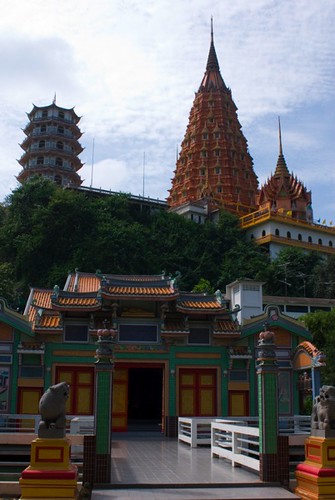
Wat Tham Khao Noi?
This may sound like a question but it is, infact, the name of one of two twin hilltop temples just south of Kanchanaburi that we visited on Monday 24th November. We took a bus out of the central bus station to a junction near a dam then got on the back of two motorcycle taxis over the dam wall for the 6km ride to the base of the hill.
As we motored along, I sped while Georgia’s driver took it more slowly for her and the bump, I looked up for the hill and its temples. The only hills I could see where miles away and devoid of any roofs, prangs or chedis. I began to think we must be heading the wrong way, abducted by highwaymen motorcycle taxi drivers taking us deep into woodland to bag our wallets. The photos I had seen of the temples showed three pagodas crowning a steep wooded mountain top that clearly towered over the surrounding land. The guide books talked of a funicular railway to take pilgrims and tourists to the top.
The road took turns in alternate directions. The hills were not visibly getting any nearer so clearly they were more than 6km away. Then, after one final turn to the left the pagodas came into view, barely rising above the nearest banana plantation. What in my expectation had been a cloud-scraping mountain turned out to be a much less lofty hill, one that could easily be at home in Norfolk. We were delivered to the base of the protuberance right at the start of the not-much-larger-than-toy-sized funicular, a track of not more than 100 metres on which ran two silver ‘carriages’ with enough space to take maybe four or five families. We succumbed, shunning the short flight of steps next door for a 10 baht, 10 second shudder up the escarpment and on to the plateau.
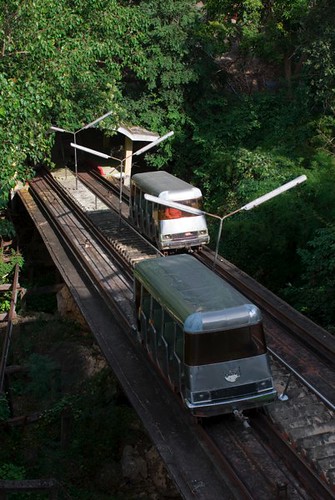
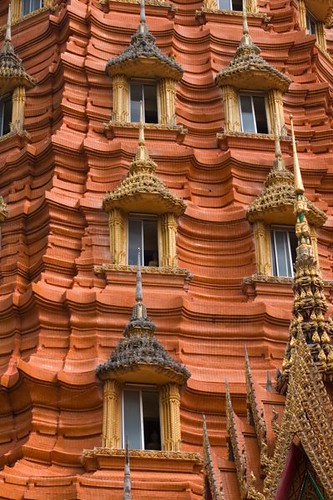
The two temples are one Thai Buddhist and one Chinese Buddhist. The Thai temple - Tham Khao Noi - has a giant, golden mosaic-covered Buddha that sits within a flame shaped canopy next to red-roofed temple halls and two orange pagodas tapering to golden points. No surface is left unpainted, ungilded or devoid of a twist or turn of some form of architectural embellishment. Each pagoda contains numerous Buddha statues in window niches on seven dark floors. The small windows allow in only narrow shafts or light that are hardly augmented by strip lighting. Sometimes two or three Buddhas are stuffed into a niche or a larger group are deposited seemingly randomly on a table. The views down onto the other temple buildings and across vivid green rice paddies to distant wooded hills are those of built and natural tranquillity.
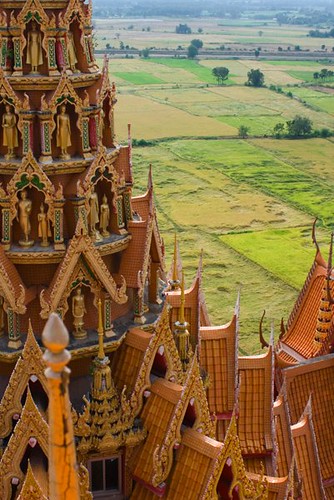

But all the time there is another presence looming. This is the Chinese pagoda of Wat Tham Suew next door. Totally different in style, the hexagonal, vertical-walled pagoda is seven floors of large, flat pastel colours, each floor under a sloping tiled roof so archetypical of Chinese style. Buddha statues could be glimpsed silhouetted in the doors. Inside, a single Buddha statue occupies the centre of each floor and the feeling is of natural light, open, uncluttered spaces that are freshened by gentle breezes. Outside the ornate clutter of the Thai pagodas make architecturally wrought attention-grabbing stratagems less anyone dwells too much within the Chinese pagoda.
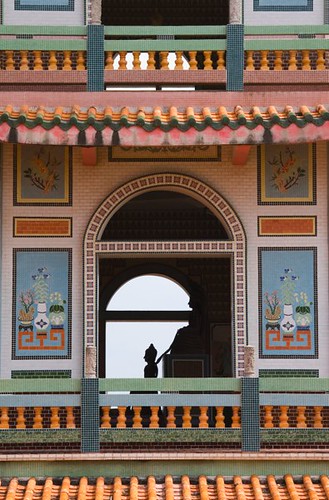
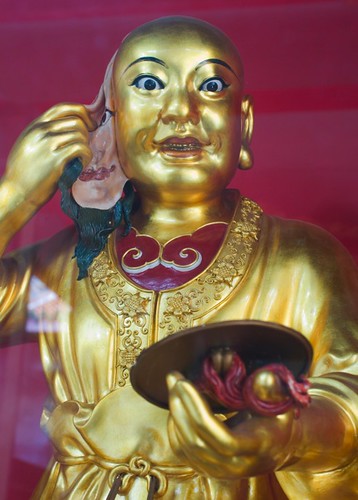
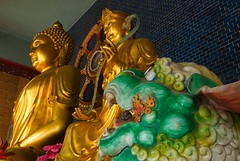
The way up to the Chinese pagoda is not gifted with a funicular, but instead is a series of Escher-like stairways and walkways threading through a number of temples complete with Chinese statues of characters that clearly evoke thought-provoking stories on ways of living. Inside the pagoda, the walls are decked with thousands of tiles, each with a small Buddha image. As we descended back to terra firma we heard chanting and a bell from one of these and saw a lone orange-robed monk praying before one of the Buddhas. The long decay of the bell and the sonorous chant held peace in the air.

As we motored along, I sped while Georgia’s driver took it more slowly for her and the bump, I looked up for the hill and its temples. The only hills I could see where miles away and devoid of any roofs, prangs or chedis. I began to think we must be heading the wrong way, abducted by highwaymen motorcycle taxi drivers taking us deep into woodland to bag our wallets. The photos I had seen of the temples showed three pagodas crowning a steep wooded mountain top that clearly towered over the surrounding land. The guide books talked of a funicular railway to take pilgrims and tourists to the top.
The road took turns in alternate directions. The hills were not visibly getting any nearer so clearly they were more than 6km away. Then, after one final turn to the left the pagodas came into view, barely rising above the nearest banana plantation. What in my expectation had been a cloud-scraping mountain turned out to be a much less lofty hill, one that could easily be at home in Norfolk. We were delivered to the base of the protuberance right at the start of the not-much-larger-than-toy-sized funicular, a track of not more than 100 metres on which ran two silver ‘carriages’ with enough space to take maybe four or five families. We succumbed, shunning the short flight of steps next door for a 10 baht, 10 second shudder up the escarpment and on to the plateau.


The two temples are one Thai Buddhist and one Chinese Buddhist. The Thai temple - Tham Khao Noi - has a giant, golden mosaic-covered Buddha that sits within a flame shaped canopy next to red-roofed temple halls and two orange pagodas tapering to golden points. No surface is left unpainted, ungilded or devoid of a twist or turn of some form of architectural embellishment. Each pagoda contains numerous Buddha statues in window niches on seven dark floors. The small windows allow in only narrow shafts or light that are hardly augmented by strip lighting. Sometimes two or three Buddhas are stuffed into a niche or a larger group are deposited seemingly randomly on a table. The views down onto the other temple buildings and across vivid green rice paddies to distant wooded hills are those of built and natural tranquillity.


But all the time there is another presence looming. This is the Chinese pagoda of Wat Tham Suew next door. Totally different in style, the hexagonal, vertical-walled pagoda is seven floors of large, flat pastel colours, each floor under a sloping tiled roof so archetypical of Chinese style. Buddha statues could be glimpsed silhouetted in the doors. Inside, a single Buddha statue occupies the centre of each floor and the feeling is of natural light, open, uncluttered spaces that are freshened by gentle breezes. Outside the ornate clutter of the Thai pagodas make architecturally wrought attention-grabbing stratagems less anyone dwells too much within the Chinese pagoda.



The way up to the Chinese pagoda is not gifted with a funicular, but instead is a series of Escher-like stairways and walkways threading through a number of temples complete with Chinese statues of characters that clearly evoke thought-provoking stories on ways of living. Inside the pagoda, the walls are decked with thousands of tiles, each with a small Buddha image. As we descended back to terra firma we heard chanting and a bell from one of these and saw a lone orange-robed monk praying before one of the Buddhas. The long decay of the bell and the sonorous chant held peace in the air.




No comments:
Post a Comment